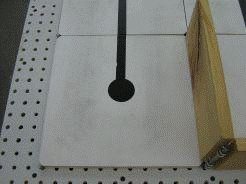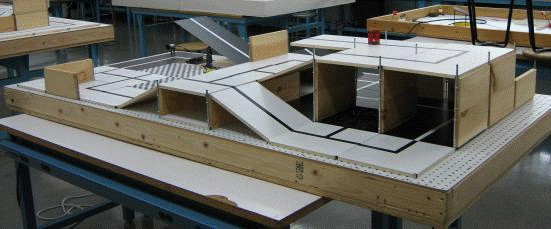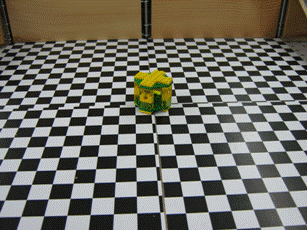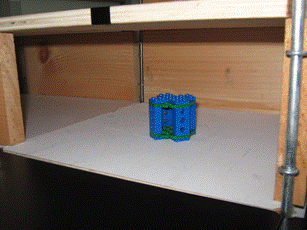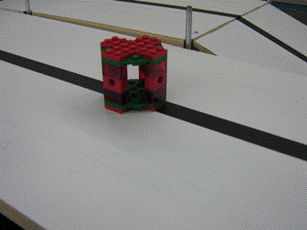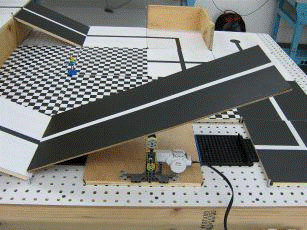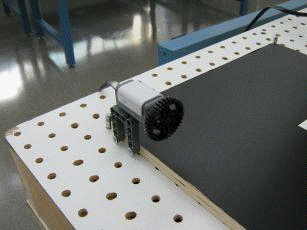Difference between revisions of "Search & Recovery Robot (SRR)"
| Line 1: | Line 1: | ||
< | <span style="display: block; font-size: 2em; font-weight: bold; border-bottom: solid 1px #003366; margin: 0.67em 0px">RFP*: Autonomous Underwater Vehicle (AUV)</span> | ||
< | <nowiki>*</nowiki> '''RFP''' is an acronym for ''Request For Proposal''. Internationally, RFPs are called ITTs, an acronym for ''Invitation To Tender'' governmental agencies use RFPs to solicit new business. | ||
RFPs are called ITTs, an acronym for | |||
governmental agencies use RFPs to solicit new business. | |||
= Introduction and Overview = | |||
In 2007, meteor Billy1987 collided with the International Space Station (ISS). The ISS orbits the moon and is a research facility assembled in space and formed among the space agencies of the US, Russia, Japan, Canada and eleven European countries. During the collision, several pieces of the ISS landed on the Moon, including "Zarya", the power supply module. NASA has issued an RFP for the development of a cost-effective autonomous robot that will retrieve Zarya. The robot should be compact in size in order to fit into the space shuttle. It will be released from the shuttle, land on the moon, traverse through the debris, retrieve Zarya, and return back to its landing site where it will take off back to the space shuttle. | |||
= Specifications = | |||
Design a robot using MLCad as your primary design tool. Your team must build a model of your design using the materials provided. A Mindstorms program that will direct the robot's movements must be created. A cost estimate of the robot's components must be provided. All revisions to the original design must be recorded and explained. This includes technical design drawings, as well as cost estimates. All revisions to the Mindstorms program must be recorded and explained. | |||
The SRR must be able to move autonomously over a pre-selected route, retrieve the power supply module Zarya, and returning them to the space shuttle (start point). Students are allowed to assist their robot in retrieval of Zarya, as long as a part of the robot is overhanging the tile where Zarya can be found at the start of the simulation. For extra credit, the robot may retrieve specific modules that have fallen off the ISS. The robot must fit in a start area that is 25cm long by 25cm wide. There is no height restriction. These specifications must be met for final commissioning. | |||
Projectile (catapult, slingshot) designs are not allowed. | |||
The robot program may not be altered or switched during any part of the mission. Likewise, the robot must be fully autonomous, and therefore cannot be touched by any person during testing. Please refer to the course syllabus for all due dates. | |||
The robot must return to the space shuttle for the robot to successfully complete the project. | |||
'''Note''': Any student who attempts to alter the course in any way, shape, or fashion (this includes lifting a tile to inspect its design) must meet with the Course Director to explain your attempt at academic dishonesty. | |||
== Route Choices == | |||
The starting point is indicated by the tile in Figure 1. | |||
< | [[Image:MSSAR1.gif|frame|center|Figure 1: SRR Landing Site<br /><span style="color: red;">'''Note: The picture above contains one representation of this project description.<br />Actual course may be different from the one pictured above, but similar in objective.'''</span>]] | ||
Your robot must retrieve Zarya (green module) shown in Figure 2. | |||
< | [[Image:MSSAR2.gif|frame|center|Figure 2: Zarya<br /><span style="color: red;">'''Note: The picture above contains one representation of this project description.<br />Actual course may be different from the one pictured above, but similar in objective.'''</span>]] | ||
Route 1: The robot must activate and travel across the Solar Panel. | |||
< | [[Image:MSSAR3.gif|frame|center|Figure 3: Solar panel route view<br /><span style="color: red;">'''Note: The picture above contains one representation of this project description.<br />Actual course may be different from the one pictured above, but similar in objective.'''</span>]] | ||
Route 2: The robot must traverse the tunnel formed from the debris of the collision. | |||
< | [[Image:MSSAR4.gif|frame|center|Figure 4: Tunnel route view<br /><span style="color: red;">'''Note: The picture above contains one representation of this project description.<br />Actual course may be different from the one pictured above, but similar in objective.'''</span>]] | ||
== Extra Credit == | |||
Extra credit is awarded to students who build a robot that retrieves modules back to the space shuttle. The point breakdown for any extra credit is outlined in the [[EG1003 Grading Policy]]. | |||
[[Image:MSSAR5.gif|frame|center|Figure 5: Unity (Node 1)]] | [[Image:MSSAR5.gif|frame|center|Figure 5: Unity (Node 1)]] | ||
| Line 53: | Line 45: | ||
[[Image:MSSAR7.gif|frame|center|Figure 7: Pirs (Docking Compartment)]] | [[Image:MSSAR7.gif|frame|center|Figure 7: Pirs (Docking Compartment)]] | ||
Extra credit will also be awarded if you traverse the "Solar Panel" after pushing the button. | |||
< | [[Image:MSSAR9.gif|frame|center|Figure 8: Solar Panel<br /><span style="color: red;">'''Note: The picture above contains one representation of this project description.<br />Actual course may be different from the one pictured above, but similar in objective.'''</span>]] | ||
< | [[Image:MSSAR10.gif|frame|center|Figure 9: Button to activate Solar Panel<br /><span style="color: red;">'''Note: The picture above contains one representation of this project description.<br />Actual course may be different from the one pictured above, but similar in objective.'''</span>]] | ||
If you would like to design your own route, you may ask your instructor for permission. | |||
Creativity and innovation are always rewarded. Original designs will receive extra credit. | |||
{{SLDP: Microsoft Project}} | |||
{{SLDP: Drawings (Robots)}} | |||
== Model == | |||
The following materials will be provided: | |||
# Mindstorms kit | |||
# One NXT/EV3 | |||
# Sensors | |||
# Motors | |||
The finished SRR must fit within the start tile which is 25cm long by 25cm wide. Any other components that the SRR uses must also fit within the tile. | |||
Additional materials can be supplied by your TA. | |||
{{SLDP: Cost Estimate}} | |||
{{SLDP: Milestones and Benchmarks}} | |||
{{SLDP: Milestone 1 (Robots)}} | |||
{{SLDP: Benchmark A}} | |||
* Travel to silver tile | |||
{{SLDP: Milestone 2 (Robots)}} | |||
{{SLDP: Benchmark B}} | |||
* Retrieve Zarya | |||
{{SLDP: Milestone 3 (Robots)}} | |||
{{SLDP: Commissioning}} | |||
* Return to start area with Zarya | |||
{{SLDP: Final Presentation}} | |||
* Problem statement | |||
* Solution overview | |||
* Company description and qualifications | |||
* Drawings | |||
* Mindstorms program | |||
* Cost estimate | |||
* Microsoft Project schedule | |||
* Video demonstration | |||
* Why should the company be awarded this contract? | |||
{{SLDP: Submission}} | |||
** Final presentation | |||
** Cover page and table of contents | |||
( | ** Final Mindstorms program | ||
** Initial sketch | |||
** All the drawings of your design (initial through final) | |||
** Video | |||
** Final MS Project Schedule | |||
** Final cost estimate | |||
** Resume(s) (No fictitious resumes will be accepted.) | |||
{{SLDP: Early Acceptance}} | |||
{{SLDP: Late Delivery}} | |||
{{Semester-Long Design Project}} | |||
Revision as of 04:38, 11 July 2014
RFP*: Autonomous Underwater Vehicle (AUV)
* RFP is an acronym for Request For Proposal. Internationally, RFPs are called ITTs, an acronym for Invitation To Tender governmental agencies use RFPs to solicit new business.
Introduction and Overview
In 2007, meteor Billy1987 collided with the International Space Station (ISS). The ISS orbits the moon and is a research facility assembled in space and formed among the space agencies of the US, Russia, Japan, Canada and eleven European countries. During the collision, several pieces of the ISS landed on the Moon, including "Zarya", the power supply module. NASA has issued an RFP for the development of a cost-effective autonomous robot that will retrieve Zarya. The robot should be compact in size in order to fit into the space shuttle. It will be released from the shuttle, land on the moon, traverse through the debris, retrieve Zarya, and return back to its landing site where it will take off back to the space shuttle.
Specifications
Design a robot using MLCad as your primary design tool. Your team must build a model of your design using the materials provided. A Mindstorms program that will direct the robot's movements must be created. A cost estimate of the robot's components must be provided. All revisions to the original design must be recorded and explained. This includes technical design drawings, as well as cost estimates. All revisions to the Mindstorms program must be recorded and explained.
The SRR must be able to move autonomously over a pre-selected route, retrieve the power supply module Zarya, and returning them to the space shuttle (start point). Students are allowed to assist their robot in retrieval of Zarya, as long as a part of the robot is overhanging the tile where Zarya can be found at the start of the simulation. For extra credit, the robot may retrieve specific modules that have fallen off the ISS. The robot must fit in a start area that is 25cm long by 25cm wide. There is no height restriction. These specifications must be met for final commissioning.
Projectile (catapult, slingshot) designs are not allowed.
The robot program may not be altered or switched during any part of the mission. Likewise, the robot must be fully autonomous, and therefore cannot be touched by any person during testing. Please refer to the course syllabus for all due dates.
The robot must return to the space shuttle for the robot to successfully complete the project.
Note: Any student who attempts to alter the course in any way, shape, or fashion (this includes lifting a tile to inspect its design) must meet with the Course Director to explain your attempt at academic dishonesty.
Route Choices
The starting point is indicated by the tile in Figure 1.
Your robot must retrieve Zarya (green module) shown in Figure 2.
Route 1: The robot must activate and travel across the Solar Panel.
Route 2: The robot must traverse the tunnel formed from the debris of the collision.
Extra Credit
Extra credit is awarded to students who build a robot that retrieves modules back to the space shuttle. The point breakdown for any extra credit is outlined in the EG1003 Grading Policy.
Extra credit will also be awarded if you traverse the "Solar Panel" after pushing the button.
If you would like to design your own route, you may ask your instructor for permission.
Creativity and innovation are always rewarded. Original designs will receive extra credit.
Microsoft Project
A project schedule must be created in Microsoft Project. Learn to use Microsoft Project by accessing the Microsoft Project Student Guide. This schedule must include all tasks related to the project from the start of the project to Early or Final submission. Click here to access the guide on how to transfer a file. The Microsoft Project schedule should include:
- Minimum of 20 tasks, excluding Milestones
- Milestones should be clearly indicated on the project plan (duration of zero days)
- Each task must include the person responsible for completing the task (resource names)
- Use the "Copy Picture" function to include the schedule in the presentations. Do not take a screenshot
- Gantt chart must be displayed alongside the tasks list (fit onto one slide)
- Gantt chart must show a progress line
- Clearly state during the presentations whether the project is on-time, behind schedule, or ahead of schedule
For help planning the project, review the manual page Planning Project Scheduling & Costs.
Drawings
All drawings and sketches should be made using LEGO Digital Designer (LDD). LDD can be installed for free from the LEGO website.
Using LDD, create four drawings of the robot: front, top, most detailed side, and a drawing of the gear train(s). Sensors, motors, and gears must be included in each drawing. If the robot does not use any gears, make sure to explicitly state that in your presentations.
Each revision of the design must be documented and all changes must be presented during Milestone presentations.
Model
The following materials will be provided:
- Mindstorms kit
- One NXT/EV3
- Sensors
- Motors
The finished SRR must fit within the start tile which is 25cm long by 25cm wide. Any other components that the SRR uses must also fit within the tile.
Additional materials can be supplied by your TA.
Cost Estimate
Once a robot design is complete, a cost estimate must be generated that specifies the cost of all the materials and labor required for the construction of the design. Tabulate this cost information clearly in an Excel spreadsheet, using the materials cost list provided. Help in calculating the cost is available by reviewing how to plan the schedule and calculate costs for a project. The costs for the parts can be found on the price list for LEGO parts for robot projects.
Note: You should only use the materials contained in the price list for LEGO parts for robot projects. If you want to use other parts, get permission from your faculty member to do so, and also to determine the cost of the parts you want to use that are not in this price list.
The cost estimate should include the following:
- Labor cost breakdown with hours and rates
- Consolidate low-cost pieces: axles, beams, bricks, bushings, connectors, gears, plates
- Itemize high-cost pieces: controllers (EV3 brick), sensors, motors
- No decimal places; this is an estimate after all. Round appropriately
- Total cost must be shown in the bottom right corner
Notebook/Project Journal
While working on your project, you are expected to keep a record of all work done, as well as future plans and goals. In order to complete a Benchmark assessment, you must submit your notebook in .pdf format to the EG1004 website, as well as show your notebook to the Open Lab TA completing your assessment. A guide to writing the notebook, as well as a basic overview of its expectations, can be found here.
Milestones, Benchmarks, and Deliverables
As work is done on the project, three Milestone presentations will report on the project's progress. All of the items assigned in each phase of the project are called Benchmark deliverables. These deliverables often consist of a combination of written submissions, presentations, and demonstrations. Benchmark assessments evaluate the progress of the project.
Preliminary Design Investigation
The Preliminary Design Investigation (PDI) is extremely important, as it lays the groundwork for the project. It outlines the project idea, inspiration, and goals.
The PDI must include:
- Cover Page
- Project Overview
- Goals & Objectives
- Design & Approach
- Cost Estimate
- Project Schedule
- Relevant Pictures
An example PDI template can be found here. The PDI is due by Benchmark A. Do not forget to include the items listed above. Use this link to access the VEX PDI Rubric.
Milestone 1
See How To Give a Milestone Presentation for the format of a Milestone presentation.
Milestone 1 is a presentation of the PDI. It is important that it outlines the project goals and show that the project is realizable.
The Milestone 1 presentation must include:
- Company profile
- Company name
- Product name
- Company officer title(s)
- Mission statement
- Project objective
- What is the project about?
- What tasks is the company aiming to accomplish? (Benchmark A requirements)
- Overall design approach to complete objective
- Background information
- Why is the project happening?
- What does the audience need to know?
- Technical design description
- Preliminary conceptual drawing of robot design
- Rendered and digital sketches are acceptable, CAD not required
- What components will be used and why?
- Preliminary conceptual drawing of robot design
- Cost estimate
- Major components of design listed
- Miscellaneous category listed
- Projected labor listed
- Microsoft Project schedule
- Click here to access the guide on how to transfer a file
- Teamwork agreement summary
- Summary
- Overall assessment on current state of project
- Is the project on schedule? Is it on budget?
- Next steps and future tasks
Look Ahead: What tasks are planned between now and Milestone 2?
Benchmark Assessment A
Benchmarks evaluate the progress of the project. Benchmark A is due at the end of Model Shop Session II. There are penalties for not completing this on time. Refer to the EG1004 Grading Policy for more information.
To pass Benchmark A, the design must complete all of the following:
- Travel to silver tile
Milestone 2
See How To Give a Milestone Presentation for the format of a Milestone presentation.
Milestone 2 Deliverables:
- Presentation:
- Project description
- Design approach
- Design changes since Milestone 1
- Mission statement
- CAD drawings: top, front, most detailed side, isometric, gear train
- Mindstorms program
- Updated cost estimate (previous and current). What changes were made?
- Updated Microsoft Project schedule (previous and current). What changes were made?
- Progress update: current state of the project (time, budget, etc.)
Look Ahead: What tasks are planned between now and Milestone 3?
Benchmark Assessment B
Benchmark Assessment B is due at the end of Model Shop Session III. There are penalties for not completing this on time. Refer to the EG1004 Grading Policy for more information.
To pass, complete all of the following tasks:
- Retrieve Zarya
Milestone 3
See How To Give a Milestone Presentation for the format of a Milestone presentation.
Milestone 3 Deliverables:
- Presentation:
- Project description
- Design approach
- Design changes since Milestone 2
- Mission statement
- CAD drawings: top, front, most detailed side, isometric, gear train
- Mindstorms program
- Updated cost estimate (previous and current). What changes were made?
- Updated Microsoft Project schedule (previous and current). What changes were made?
- Progress update: current state of the project (time, budget, etc.)
Look ahead: What tasks are planned between now and the completion of the project?
Commissioning
Projects must be commissioned before Submission. Refer to the syllabus for Submission deadlines. There are penalties for not completing this on time. Refer to the EG1004 Grading Policy for more information.
To pass, the design must complete all of the following:
- Return to start area with Zarya
Final Presentation
The Final Presentation will be a technical briefing, similar to the Milestones, but also serves as a sales presentation explaining why your company should be selected instead of the competition.
Your Final Presentation must include:
- Company profile
- Company name
- Employee profile, role(s), and qualifications
- Mission statement
- Problem statement
- Why is the project happening?
- What does the audience need to know?
- Project objective
- What is the purpose of your project?
- Who does your project help?
- What problem does your project solve?
- Project description
- Specify LEED certification
- Examples of LEED implementations in Revit
- Revit drawings
- All floor plan drawings
- Dimensions
- 1:240 scale
- Views of exterior of building: front elevation, side elevation, isometric elevation
- Dimensions
- Specify LEED certification
- Market and product viability
- Does your company have competitors?
- What makes your project unique?
- How does your design compare to competitors - cost, quality, features?
- Is the project versatile?
- What is the price of your project?
- Conclusion
- Reiterating project purpose
- Highlight project features
- Future goals of the company
- Why should your company be awarded this contract?
- Video pitch
- Price of project
- Walkthrough animation of building in Revit
- Embedded into Final Presentation
- Problem statement
- Solution overview
- Company description and qualifications
- Drawings
- Mindstorms program
- Cost estimate
- Microsoft Project schedule
- Video demonstration
- Why should the company be awarded this contract?
Submission
All SLDPs must be submitted online. Please visit this page for the link to the Project Submission form and each project’s individualized login information. To submit, login to the EG1004 website using this special login information. Submitting with an NYU account or any other account will generate an error. Components may be resubmitted at any time before the deadline. Please note that submission times are based on the most recent submission.
Please note the deliverables for this project are as follows. If any of the following items are omitted, there will be a penalty. Be sure to click "Submit" at the bottom of the form and allow sufficient time for uploading. The following list includes deliverable items that are required:
- Submission deliverables:
- Final presentation
- Cover page and table of contents
- Final Mindstorms program
- Initial sketch
- All the drawings of your design (initial through final)
- Video
- Final MS Project Schedule
- Final cost estimate
- Resume(s) (No fictitious resumes will be accepted.)
Early Submission
If the project is submitted one academic week early (before the end of the lab period the week before the Final Submission deadline), the project is eligible for a bonus that will be added to the final SLDP grade. All deliverables must be submitted one academic week before the submission deadline (see syllabus for the exact date). The deliverables received early are the ones that will be used in the Final Presentation. No changes to the submitted deliverables will be accepted.
Late Submission
Late submission is not allowed. If a project does not Commission or receive Partial Commission by the deadline set forth in the syllabus, the project will not be allowed to submit and will receive a 0 for the project grade. To receive Partial Commissioning, two TAs must evaluate the project and determine its degree of completion according to the Commissioning requirements and the project will be given a grade accordingly. Please refer to the EG1004 Grading Policy for more information.
| ||||||||
